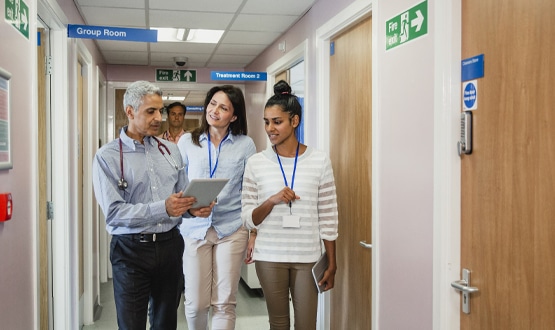Laying the foundations for the digital revolution
- 16 December 2015

Health and social care organisations are on a new five-year journey to deliver integrated health and social care, underpinned by effective use of digital technologies.
The aim is to enable by a new era of collaboration for health and care communities, to reduce the inefficiencies of paper, and to place patients and their carers in direct control of their health.
While much of the focus is currently on application interoperability, the underpinning infrastructure and collaboration environment must not be ignored.
These components provide the platform for successful application delivery that will enable business and clinical needs to be met.
“Interoperability and integration are just one element of an enterprise architecture that will enable health and care organisations to achieve their aims,” says Terry Espiner, client director – UK healthcare at Cisco Systems.
“One might consider the application layer to be about digitisation. Whereas digital technology is concerned with the emerging Internet of Everything, collaboration tools, security and underpinning infrastructure. Both need equal levels of attention and investment for successful business returns.”
An architectural blueprint
Cisco has developed new guidance for health and care organisations, known as ‘Digital Strategy for Connected Health and Care’. It is the third version of the Cisco Network Architecture Blueprint (C-NABv3), and will be launched early in 2016.
Espiner urges that the new C-NAB documents be used by clinical commissioning groups, NHS trusts and social care providers who are beginning to jointly draw up the local digital road maps that NHS England has asked them to complete by spring next year.
C-NAB advocates a business led approach to planning strategic investments in technology. Complementing this, it also advises on the order of technology deployment to best support those business needs. “C-NAB is a route to delivering business capability” says Espiner.
The technology foundations of C-NABv3 are in data centre, enterprise networks, collaboration (combining voice, data and other traffic) and security. But the blueprint also examines emerging technologies and delivery models, including cloud.
Security
Security is now so important that Cisco has identified it as a dedicated solution set. Espiner says: “Our approach to security builds on the NHS’ work on information governance.
“However, we believe that much more needs to be done, and can be done. Security should be intrinsic to any NHS organisation; through business, application and technology layers.”
He adds: “The network is the logical place to begin with security as the network touches everything. We firmly believe that the question that the NHS should be asking itself is no longer: ‘How do we prevent a security breach?’ but: ‘How quickly can we recover in the event of a security breach and how do we minimise the impact of any breach?’
“The focus needs to be on before, during and after any security breach.” Espiner also emphasises the need for security to cover all the devices that NHS organisations may now find connecting to their networks; and that will be connecting in the future.
Cisco is forecasting exponential growth of network connected devices, sensors and monitors, known as the Internet of Everything. “Look at your personal connectedness today, with phones, tablets, laptops, health trackers. This is just the beginning. By 2020 there will be 50 billion devices connected to the internet. How will you secure them?”
Collaboration tools
The NHS has to achieve £22 billion of productivity savings by 2020. Cisco believes that one of the greatest areas of opportunity to make inroads into these figures is harnessing digital technology to improve collaboration, reduce travel, enable mobile working and support better patient outcomes.
Espiner says savings can be achieved by making use of a variety of proven collaboration tools; the workhorses of many other sectors.
Examples include: “IP [internet protocol] telephony, omni-channel contact centres, video and web collaboration tools such as Webex, Jabber and Spark. Video solutions are also highly scalable, supporting group working such as multi-disciplinary team meetings.”
Espiner says there are many “pinch points” across the NHS that could be addressed through more widespread use of collaboration tools.
“For example, Airedale NHS Foundation Trust is making great use of video consultations with care homes, and have managed to reduce their use of A&E by in excess of 50%.”
In another example Cisco is working with a CCG to treat patients with hypertension at home. It is believed that a 2% reduction in GP appointment bookings is possible; which would equate to a total of 1,200 appointments from one GP surgery alone.
The same technology platform that a hospital uses should be used to support these type of services, says Espiner. “We need to provide patients with a digital NHS front door. It’s just a question of enabling the service.”
Getting the board connected to digital technology
Although infrastructure and communications are often thought of as bits of plumbing, they are fundamental to the business and strategic aims of NHS organisations. “It puzzles us in Cisco why digital technology is not a board-level issue in every trust.”
Some trusts, for instance, still use outmoded technology long after nearly everyone else has moved on. “Many trusts have moved towards IP telephony since 2001, and achieved simple cost savings and efficiency gains as a result.
“So it’s hard to believe that there are still many further trusts using traditional telephony technology, which is a huge barrier,” says Espiner.
He recently came across one trust that is replacing a telephony system that is 14-years old; and using a version of software that hasn’t been supported for five years.
And he knows of two cases in which network failures have led to hospitals being closed down to emergency admissions. In both cases, the failure was down to their using equipment that was past its end of life.
In addition, Espiner argues, once a platform has been developed, it is available for re-use for multiple operational and service delivery use cases, which can deliver significant innovation.
The problem is that underpinning technology is often invisible and isn’t sufficiently valued. “Too many trusts do not see it as a business enabling asset, in the way that other businesses do. They don’t realise its importance until it is too late.”
Boom and bust
Another long-term problem with NHS investments in infrastructure is that they tend to be cyclical; years of under-investment followed by occasional splurges of catch-up investment.
This boom and bust cycle is exacerbated by accounting practices that favour capital rather than revenue investment, and accounting practices that encourage trusts to treat infrastructure as an asset they hang onto for too long.
This focus on capital also constrains the programmatic technology investment approach that good business planning dictates. Espiner says NHS organisations need to look at moving away from capex-only models, to leasing.
“There is a very heavy emphasis on capex for technology investment, but the network is now so important it should be treated as a fourth utility, while long term planning in enabling technologies demands a lifecycle approach.”
A further challenge can be decision-making processes. These can be so long that the technology chosen is almost redundant by the time a business case is approved. “We’re working with partners where the discussions with the customer have been ongoing for four years.”
In summary, Espiner suggests that health and care organisations mirror the approach seen in other sectors of business, where technology is an inherent part of future planning, leading to co-ordinated, programmatic investment.




